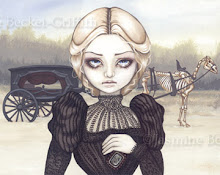 |
| Front and back covers of the Wallace Hartley mourning card. |
Here we have an exciting example of a mourning card that is not quite an antique, this card was commissioned to commemorate the life of Wallace Hartley, bandmaster of the ill-fated RMS Titanic.
 |
| Inside view of the same mourning card. |
The card itself is in excellent condition, to the front cover a simple black boarder to cream card with the words; “In memory of Wallace Hartley” in black “of the period” font. Upon opening the card we are greeted with a wonderful sight; framed in silver, on the left; the music score and words to the hymn “Nearer my god to thee” and to the right; an image of Hartley and the Titanic with the words; “The musician hero of the Titanic who foundered April 14th, 1912” central. The reverse of the card is plain albeit for a black boarder.
 |
| Image of Wallace Hartley. |
Hartley was born on 2nd June 1878 in Colne, Lancashire, England, and Hertleys’ father was a choirmaster at the Bethel Independent Methodist Chapel. It was here, taught by a fellow of the congregation, that Hartley learnt to play the violin.
After persuading his parents to allow him to pursue a career in music, Hartley moved to Dewsbury, West Yorkshire, and began working for Cunard Line ocean liners. By 1912, Hartley was in the employment of C.W. & F.N Black, who supplied musicians for both Cunard and White Star, the company that owned and commissioned the Titanic.
As April 1912 came around, Hartley was newly engaged to his fiancée Maria Robinson, and was hesitant to take the role of bandmaster of the Titanic when it was offered. Even though he was not comfortable leaving his partner, Hartley agreed to take the position in the hopes of furthering his career.
 |
| An image of the Titanic. |
The Titanic’s demise is well documented and has been popularised by the Hollywood film adaptation. Hitting an iceberg at 11.40pm a series of catastrophes followed, the flooding of six forward compartments overwhelmed the stability of the ship, eventually leading to the hull breaking into two sections due to emeses stress. By 2.20am both sections of the ship had sunk.
There is much written on the fate of the Titanic, who is at fault, and the engineering flaws that ultimately led to its sad ending, it is not for me to give weight or credence to any argument, I simply yearn to tell the story of the lives involved.
Much has been made, quite rightly, of the acts of heroism witness on this terrible night. Wallace Hartley joins the ranks with one such legendary act of human compassion. As panic gripped the passengers aboard, Hartley and his band played to quell the passengers as they loaded the lifeboats. Witnesses reported the band continued to play until the end. It is not known for certain which song was played as the Titanic went down, but popular legend instils “Nearer my God to thee” was the choice, it has also been reported that Hartley remarked, if he ever were to go down on a sinking ship his choice of song to play would indeed be “Nearer my God to Thee” or “O God, our help in ages past”.
A national newspaper at the time stated; "the part played by the orchestra on board the Titanic in her last dreadful moments will rank among the noblest in the annals of heroism at sea." It is selfish acts such as these that earn individuals a glimmer of immortality; their legends live on so to speak.
Two weeks after the disaster, on May 4th, Hartley’s body was recovered from the waters, his being body number 224 . He still had his music box strapped about him and his gold fountain pen, engraved with the initials W.H.H, in his pocket.
 |
| Image of the funeral procession for Wallace Hartley. |
On 18th May 1912 , 40,00 people lined the streets of Hartleys birth town to witness his funeral procession, while a further 1000 attended the funeral held at Bethel Chapel. Hartley was laid to rest in his familys’ tomb that bares the inscription;
“In Loving Memory of Wallace Henry, The beloved son of Albion and Elizabeth Hartley Formerly of Colne Who lost his life in the S.S. Titanic Disaster on April 15th, 1912, Aged 33 years. And was interred on May 18th 1912.”
 |
| The memorial dedicated to Wallace Hartley in Colne. |
A beautiful monument, erected in 1915, now stands in the grounds of the rectory. It features a bust of Hartley, a dedication, and a fittingly, violin at its base. The inscription upon this monument reads;
“Wallace Hartley, Bandmaster of the RMS Titanic who perished in the foundering of that vessel April 15th 1912, Erected by voluntary contributions to commemorate the heroism of a native of this town.”

























